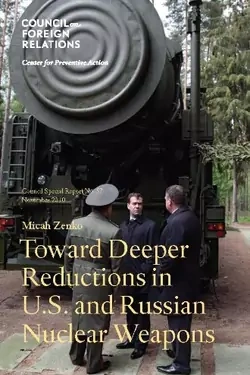
Toward Deeper Reductions in U.S. and Russian Nuclear Weapons

- Council Special Report
- Concise policy briefs that provide timely responses to developing crises or contributions to current policy dilemmas.
Overview
The New START Treaty, signed by presidents Barack Obama and Dmitry Medvedev in April 2010, was an important achievement. A follow-on to the 1991 START treaty, New START commits both countries to substantial reductions in their nuclear arsenals. Pending ratification in the Russian Duma and U.S. Senate, New START limits both countries to 1,550 deployed strategic nuclear warheads—far below the Cold War peak of 31,000 strategic and tactical nuclear weapons in the United States alone. Moreover, the New START treaty furthers Obama's goal of "resetting" U.S.-Russia relations. In just the past two years, the former adversaries also finalized an agreement on plutonium disposition, imposed UN sanctions against Iran in reaction to its nuclear program, and enhanced security for non-deployed tactical nuclear weapons.
Despite these signs of progress, it is unwise to be complacent. Even after the implementation of the New START Treaty, Obama's goal of a "world free of nuclear weapons" will remain elusive—the United States and Russia will still command enough nuclear weapons to annihilate each other several times over. In this Council Special Report, Fellow for Conflict Prevention Micah Zenko argues that reducing nuclear weapons stockpiles even further than New START treaty levels—to one thousand warheads, including tactical nuclear weapons—would be both strategically and politically advantageous. It would decrease the risk of nuclear weapons theft and nuclear attack and increase international political support for future U.S. initiatives to reduce or control nuclear warheads, all while maintaining a credible nuclear deterrent.
More on:
To achieve such a significant reduction in a follow-on to the New START treaty, the United States and Russia would need to reach agreement on three long-standing and contentious issues. Tactical nuclear weapons deployments will be the most difficult of these challenges, Zenko writes, since Russia has a much larger arsenal of tactical nuclear weapons than does the United States and will therefore bear the brunt of the tactical nuclear weapons cuts. Missile defense is the second obstacle toward further significant nuclear reductions. Much work remains to secure Moscow's cooperation on—or acceptance of—the project. Finally, the United States and Russia must reach agreement on the use of nuclear vehicles for conventional weapons. It is difficult to overstate the potential danger if either country mistook a conventional missile for a nuclear one.
Toward Deeper Reductions in U.S. and Russian Nuclear Weapons makes a thoughtful contribution to the discussion on how to build a stable future with far fewer nuclear weapons. With ongoing debate over the New START treaty in the Senate, this CSR serves as a reminder that there is more work to be done.
More on:
 Online Store
Online Store